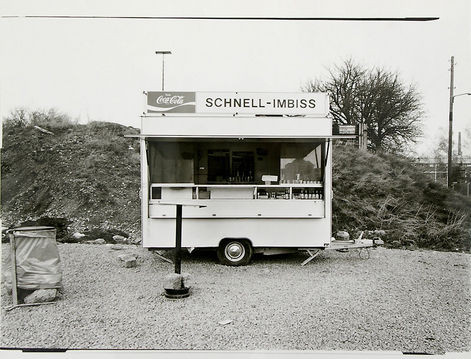Max Regenberg and Tata Ronkholz
10 Nov 2012 - 19 Jan 2013

Tata Ronkholz
Trinkhalle Nr. 49, 1978 - 1985
From the series Trinkhallen
Gelatin silver print
9 x 12 inch / 24 x 31 cm
Trinkhalle Nr. 49, 1978 - 1985
From the series Trinkhallen
Gelatin silver print
9 x 12 inch / 24 x 31 cm
MAX REGENBERG AND TATA RONKHOLZ
10 November 2012 - 19 January 2013
Photographs by Max Regenberg and Tata Ronkholz are exhibited concurrently on the upper floor of the gallery.
Max Regenberg (b. in Duisburg-Rheinhausen in 1951) emigrated to Canada after finishing his training as an advertising photographer and today lives in Cologne. On view are b/w-photographs from Regenberg’s series M Come To Where (1984-2002), which investigates the myth of the Marlboro Cowboy from the influential campaign of the American cigarette brand. Since the late 1970s, Regenberg has worked on a long-term photographic study on billboards in public space. He was inspired to this project in North America, which in the mid-70s was already the Eldorado of oversized billboards, the Marlboro Cowboy being one of its protagonists. In Regenberg’s series the American advertising myth meets the urban landscape, which creates a unique and peculiar tension between two visual systems. The re-photographed images enter into a new context and thus draw attention to the fact that public space and everyday life are continually aestheticized and economized. The exhibition is accompanied by the publication M Come To Where (White Press, 2011).
Similarly to Regenberg’s work, Tata Ronkholz’ series Trinkhallen documents elements of urban architecture, which due to their transient nature turn the photographs into valuable historical documents. The photographer Tata Ronkholz (b. in Krefeld in 1940, died in 1997) was among the first students of Bernd Becher at the Kunstakademie Düsseldorf. Even before she began to study with Bernd and Hilla Becher in 1978, she made her first black and white photographs of industrial sites, which she took with a view camera only during the winter months, so the vegetation would not cover up the structure of the gates. The exhibition presents her perhaps best known and most extensive work group Trinkhallen, kiosks that mostly do not exist any more. Ronkholz found her characteristic subjects in Cologne, Düsseldorf, Bochum, and parts of the Rhineland. “I was neither interested in the social aspect nor in the design, but felt drawn to the everyday. I wanted to show the kiosk around the corner in all its amiableness.” (Tata Ronkholz)
10 November 2012 - 19 January 2013
Photographs by Max Regenberg and Tata Ronkholz are exhibited concurrently on the upper floor of the gallery.
Max Regenberg (b. in Duisburg-Rheinhausen in 1951) emigrated to Canada after finishing his training as an advertising photographer and today lives in Cologne. On view are b/w-photographs from Regenberg’s series M Come To Where (1984-2002), which investigates the myth of the Marlboro Cowboy from the influential campaign of the American cigarette brand. Since the late 1970s, Regenberg has worked on a long-term photographic study on billboards in public space. He was inspired to this project in North America, which in the mid-70s was already the Eldorado of oversized billboards, the Marlboro Cowboy being one of its protagonists. In Regenberg’s series the American advertising myth meets the urban landscape, which creates a unique and peculiar tension between two visual systems. The re-photographed images enter into a new context and thus draw attention to the fact that public space and everyday life are continually aestheticized and economized. The exhibition is accompanied by the publication M Come To Where (White Press, 2011).
Similarly to Regenberg’s work, Tata Ronkholz’ series Trinkhallen documents elements of urban architecture, which due to their transient nature turn the photographs into valuable historical documents. The photographer Tata Ronkholz (b. in Krefeld in 1940, died in 1997) was among the first students of Bernd Becher at the Kunstakademie Düsseldorf. Even before she began to study with Bernd and Hilla Becher in 1978, she made her first black and white photographs of industrial sites, which she took with a view camera only during the winter months, so the vegetation would not cover up the structure of the gates. The exhibition presents her perhaps best known and most extensive work group Trinkhallen, kiosks that mostly do not exist any more. Ronkholz found her characteristic subjects in Cologne, Düsseldorf, Bochum, and parts of the Rhineland. “I was neither interested in the social aspect nor in the design, but felt drawn to the everyday. I wanted to show the kiosk around the corner in all its amiableness.” (Tata Ronkholz)
